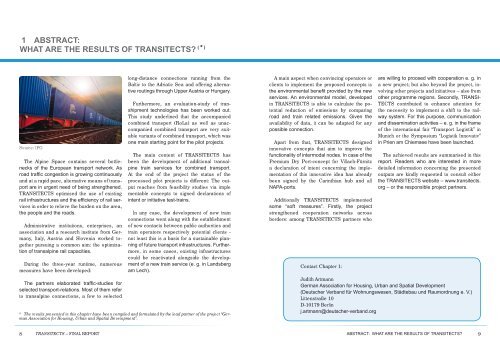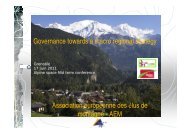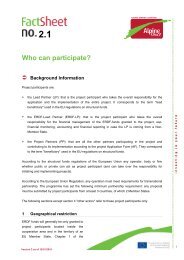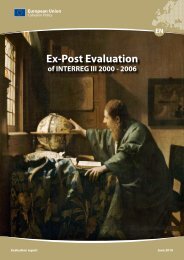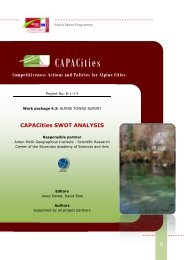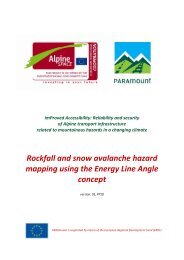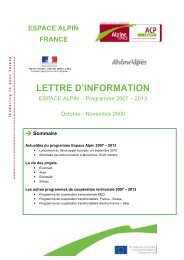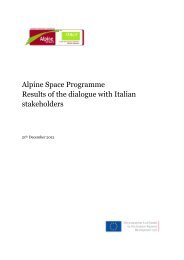intermodal solutions for transalpine freight traffic - Alpine Space ...
intermodal solutions for transalpine freight traffic - Alpine Space ...
intermodal solutions for transalpine freight traffic - Alpine Space ...
Create successful ePaper yourself
Turn your PDF publications into a flip-book with our unique Google optimized e-Paper software.
1 absTraCT:<br />
whaT are The resulTs of TransITeCTs? (*)<br />
Source: IPG<br />
The <strong>Alpine</strong> <strong>Space</strong> contains several bottlenecks<br />
of the European transport network. As<br />
road <strong>traffic</strong> congestion is growing continuously<br />
and at a rapid pace, alternative means of transport<br />
are in urgent need of being strengthened.<br />
TRANSITECTS optimised the use of existing<br />
rail infrastructures and the efficiency of rail services<br />
in order to relieve the burden on the area,<br />
the people and the roads.<br />
Administrative institutions, enterprises, an<br />
association and a research institute from Germany,<br />
Italy, Austria and Slovenia worked together<br />
pursuing a common aim: the optimization<br />
of <strong>transalpine</strong> rail capacities.<br />
During the three-year runtime, numerous<br />
measures have been developed:<br />
The partners elaborated <strong>traffic</strong>-studies <strong>for</strong><br />
selected transport-relations. Most of them refer<br />
to <strong>transalpine</strong> connections, a few to selected<br />
long-distance connections running from the<br />
Baltic to the Adriatic Sea and offering alternative<br />
routings through Upper Austria or Hungary.<br />
Furthermore, an evaluation-study of transhipment<br />
technologies has been worked out.<br />
This study underlined that the accompanied<br />
combined transport (RoLa) as well as unaccompanied<br />
combined transport are very suitable<br />
variants of combined transport, which was<br />
one main starting point <strong>for</strong> the pilot projects.<br />
The main content of TRANSITECTS has<br />
been the development of additional <strong>transalpine</strong><br />
train services <strong>for</strong> combined transport.<br />
At the end of the project the status of the<br />
processed pilot projects is different: The output<br />
reaches from feasibility studies via imple<br />
mentable concepts to signed declarations of<br />
intent or initiative test-trains.<br />
In any case, the development of new train<br />
connections went along with the establishment<br />
of new contacts between public authorities and<br />
train operators respectively potential clients -<br />
not least this is a basis <strong>for</strong> a sustainable planning<br />
of future transport infrastructures. Furthermore,<br />
in some cases, existing infrastructures<br />
could be reactivated alongside the development<br />
of a new train service (e. g. in Landsberg<br />
am Lech).<br />
* The results presented in this chapter have been compiled and <strong>for</strong>mulated by the lead partner of the project “German<br />
Association <strong>for</strong> Housing, Urban and Spatial Development”.<br />
A main aspect when convincing operators or<br />
clients to implement the proposed concepts is<br />
the environmental benefit provided by the new<br />
services. An environmental model, developed<br />
in TRANSITECTS is able to calculate the potential<br />
reduction of emissions by comparing<br />
road and train related emissions. Given the<br />
availability of data, it can be adapted <strong>for</strong> any<br />
possible connection.<br />
Apart from that, TRANSITECTS designed<br />
innovative concepts that aim to improve the<br />
functionality of <strong>intermodal</strong> nodes. In case of the<br />
Premium Dry Port-concept <strong>for</strong> Villach-Fürnitz<br />
a declaration of intent concerning the implementation<br />
of this innovative idea has already<br />
been signed by the Carinthian hub and all<br />
NAPA-ports.<br />
Additionally TRANSITECTS implemented<br />
some “soft measures”. Firstly, the project<br />
strengthened cooperation networks across<br />
borders: among TRANSITECTS partners who<br />
Contact Chapter 1:<br />
are willing to proceed with cooperation e. g. in<br />
a new project; but also beyond the project, involving<br />
other projects and initiatives – also from<br />
other programme regions. Secondly, TRANSI-<br />
TECTS contributed to enhance attention <strong>for</strong><br />
the necessity to implement a shift to the railway<br />
system. For this purpose, communication<br />
and dissemination activities – e. g. in the frame<br />
of the international fair “Transport Logistik” in<br />
Munich or the Symposium “Logistik Innovativ”<br />
in Prien am Chiemsee have been launched.<br />
The achieved results are summarised in this<br />
report. Readers who are interested in more<br />
detailed in<strong>for</strong>mation concerning the presented<br />
outputs are kindly requested to consult either<br />
the TRANSITECTS website – www.transitects.<br />
org – or the responsible project partners.<br />
Judith Artmann<br />
German Association <strong>for</strong> Housing, Urban and Spatial Development<br />
(Deutscher Verband für Wohnungswesen, Städtebau und Raumordnung e. V.)<br />
Littenstraße 10<br />
D-10179 Berlin<br />
j.artmann@deutscher-verband.org<br />
8<br />
transitects – final report<br />
ABSTRACT: WHAT ARE THE RESULTS OF TRANSITECTS? 9


